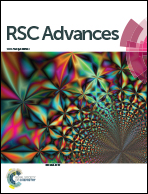Nimbolide from Azadirachta indica and its derivatives plus first-generation cephalosporin antibiotics: a novel drug combination for wound-infecting pathogens†
Abstract
The shortage of effective drugs against wound-infecting pathogens poses a serious public health threat. Combination treatment may represent a good choice for treating infections caused by these pathogens. The aim of the present study is to evaluate the in vitro efficacy of nimbolide, desacetylnimbin isolated from Azadirachta indica, and the amide derivatives of nimbolide in combination with first-generation cephalosporin antibiotics against major wound-associated bacterial pathogens. The antibacterial activities of the compounds and antibiotics were studied by calculating minimum inhibitory concentrations and minimum bactericidal concentrations. The checkerboard and time–kill assay were used to evaluate the interactions between the compounds and antibiotics. Nimbolide recorded the highest antimicrobial activity against all tested strains followed by desacetylnimbin, but the amide derivatives of nimbolide were found to be less active. The MICs of the tested compounds ranged from 64 to 2000 μg mL−1. In the checkerboard test, nimbolide and its derivatives markedly reduced the MIC values of the antibiotics. A significant synergistic effect was recorded with nimbolide as well as desacetylnimbin in combination with antibiotics, and this combination recorded significant reduction in the number of colony forming units (CFUs) in the time kill assay, and the maximum reduction was recorded between 4 and 12 h. The above combination was also found to be effective against methicillin-resistant Staphylococcus aureus (MRSA), an important drug-resistant bacterium. The cytotoxicities of the compounds were tested against H9c2 and they recorded no toxicity up to 200 μM. In summary, the combination of nimbolide/desacetylnimbin and antibiotics demonstrated synergistic activity against the major wound-associated bacteria tested in this study. Furthermore, these compounds may potentially widen the therapeutic window of antibiotics, suggesting that these combinations could be used clinically to control infections caused by wound pathogens after in vivo experiments.


 Please wait while we load your content...
Please wait while we load your content...